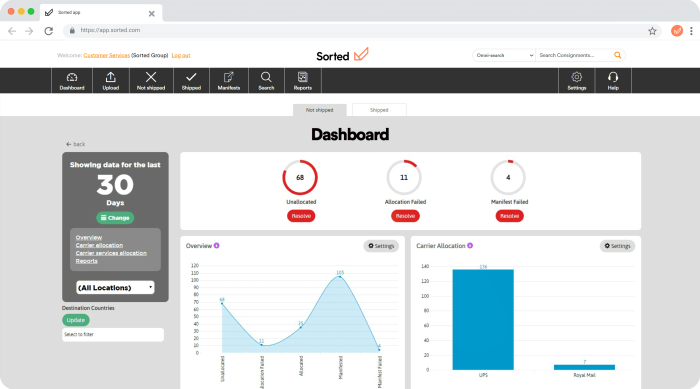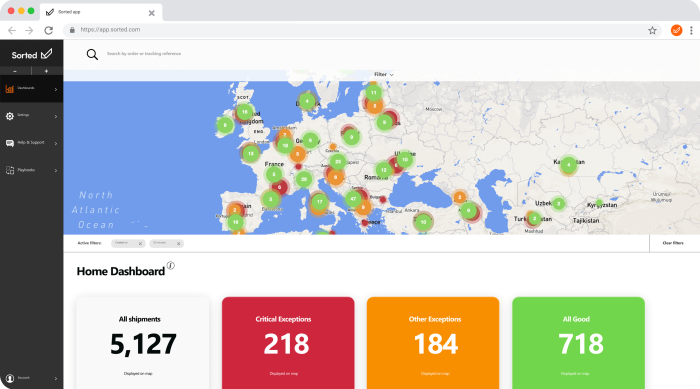The ultimate guide to building a business case for delivery experience software
You’ve done the discovery and the due diligence. You know what you want and you’re ready to sign on the line. But first, it’s time to get the business on board. Here’s a tried and tested guide to help you create a bullet-proof business case.
You’re ready to state your case for new software. Kind of.
Often, the once-attentive supplier sends over some documents and leaves you to your own devices, chasing every few days for an update.
At Sorted, we like to make everything as easy as possible for our clients – true partnerships are all about support and collaboration. Which is why we’re on hand to help at every step of the journey.
When you’re ready to put forward a case for technology investment, it can be a complex and complicated process. Every business and every procurement team have different requirements – but usually there are common components that are universally requested.
In this guide, we’re aiming to make your life easier; you’ll find all the evidence and information you need to gather as you create a strong business case, as well as lessons from the industry and some watertight hints and tips too.
Chapter 1 - The key component tick list
The stronger the case, the smoother the sign off.
After working with our retail partners for nearly a decade, we’ve seen and signed-off many a successful business case (and we’ve witnessed the horrors of the disasters too).
Regardless of procurement requirements, structure or size – here are the pillars around which every strong business case is built.
Why
The reasoning behind the project. Which problems are you trying to solve, which risks are you trying to remove, which opportunities are you trying to create?
What
Stated plain and simply; what is your proposed solution? Summarise the product – use existing literature and tailor it to your specific use cases.
Benefits
Laying out the scoped benefits of the solution, and the metrics to back it up. Here, concise layperson’s terms will have the biggest cut through.
Due diligence
Show you’ve done your homework. The powers signing off your business case (whether that be department heads, procurement bods or Exec teams) will always want to know that market research and benchmarking was done. Inclusion of a short methodology section will answer any questions like ‘what else is in the market?’.
Transparencies
It’s always best practice to be open about risks. Note any points of potential concern, and include how you’ll be working to mitigate. In this section, highlight areas in which your new supplier is open and collaborative (e.g. support channels, public opensource technical documentation) and always be clear about your internal collaboration too (e.g. is your IT team or relevant departments informed and on board?).
Timescales and budgets
Set realistic expectations. Indicative commercials and ROI calculations are useful here. But, most importantly, try to include the cost of ignoring the problem too. Here, your finance team may make your project a cost counting exercise, so try to avoid a race to the bottom with price. Be clear in your objectives and the value that can be created any solution.
Supporting docs
Include any references you think will be useful; product literature, links to customer stories, tech docs, press or media activity to show company reputation.
So, there’s your tried and tested check list.
Now, if you’re here to build your Sorted business case (or just here wondering how it would be done…), we’ve packed the rest of this page full of useful stuff. Most of the info and resources you’ll need have been handily aggregated here – and, as always, just get in touch if you need any additional info. Our helpful, friendly delivery experience specialists are always happy to provide tailored information based on your specific needs and requirements.
Chapter 2 - Product fact file
Ok, the exciting stuff.
Our delivery experience platform connects all the major touchpoints of the ecommerce journey – powering checkouts, carrier management and post-purchase tracking around the world.
For the need-to-know on each product, head to these links:
Have control over your flexible carrier and delivery ops
Single integration end-to-end delivery and carrier management.

Give your customers a 5* post-purchase experience
Automated tracking and post-purchase communications.

Chapter 3 - Back it up: Challenge vs Solution
Of course, all business cases will include details on the problem you’re looking to solve, or benefits you’re looking to realise, and the product application that will help. Stating a simple mission statement for the project is the most effective way to communicate the opportunity you’re addressing.
For example:
We have identified that our customer service agents need to be better served by our parcel tracking data, and that by arming them with stronger delivery and returns information we’re increasing the speed and accuracy of the service we offer customers.
Our existing carrier management solution is currently not fit for scale, resulting in considerable risk as we grow and respond to changing market conditions – accessing a new, agile carrier management platform future-proofs our delivery operations and allows us to add new distribution routes with new on-platform carriers.
For more use cases like these, to help with your simple mission statements, click here.
The best business cases will include stats, facts and figures to back up and strengthen points.
You have access to your own data, of course. But, often, it’s the extra, third-party info that can add weight to your case. Being as busy as you are, you probably don’t get time to trawl through the latest research reports and find all the supporting info that you need when it comes to illustrating challenges and solutions. So, we’ve done the hard work for you. As a starting point, this section compiles data from industry research and our real-world client data.
Top tip.
Identify metrics that are most relevant to your organisation. What numbers do your internal stakeholders really care about? Who are you trying to convince and what will get them excited? For example, maybe you’re totally focussed on improving NPS and CSAT metrics as a measure for CX, or maybe you’re obsessed with reducing customer churn.
We’ve split the chapter into three helpful sections…
What a poor overall delivery experience can cost you
93%
of customers read online reviews before buying, and delivery experience is consistently one of the most common sources of complaints and negative feedback for retailers.
The importance of delivery choice
Limited or static delivery options cause poor conversion and high basket abandonment – also leading to a poor overall customer experience (measured by CSAT & NPS) – whereas offering customers a better checkout experience with better delivery options can drive conversion, customer satisfaction and, ultimately, company growth.
Our client saw a
6%
increase in NPS following a better checkout experience.
Personalised delivery choice = basket conversion
Fill in the calculator for a quick estimation on what providing personalised delivery options could do for your basket conversion stats and ecommerce revenue.
1) Fill in your average basket worth (£)
2) Fill in your average number of checked out baskets (per month)
3) See what impressive revenue increases you could have
Data is based on Sorted client success metrics, and basket conversion is just one area where you can measure revenue increase.
Average basket worth (£)
Number of baskets (monthly average)
Increase in revenue with Ship
The importance of carrier management.
Poor visibility and control over delivery and carrier management often leads to broken customer promises. Getting it right pays big though – having full control and total visibility means efficiencies and cost savings. Plus, being able to track orders and fix issues means your warehouse is key in keeping customer promises.
45%
of customers would refuse to shop with a retailer or brand again following a poor delivery experience.
Delivery and Carrier management = order to contact ratio reduction
Fill in the calculator for a quick estimation of the money and contact centre minutes you could save with delivery and carrier management software.
1) Fill in your average orders per year (£)
2) Fill in your average number of WISMO customer contacts per year
3) Fill in the average cost of a WISMO customer contact(we find, on average, it can sit around the £4-£6 mark for a call)
4) Check out your potential savings
Data is based on Sorted client success metrics, and reducing your order to contact ratio is just one area where you can measure savings.
Orders per year
Customer contact per year
WISMO / Customer contact cost (£)
Money saved with Ship
Minutes saved per year
Some of our clients found:
- £10k-£20k saved in direct carrier integration costs
- 200% increase in productivity due to process improvements
- Saved time at the pack bench, processing 3 orders per minute instead of 1
The importance of post-purchase experience
A disjointed post-purchase experience undoubtably leads to unhappy customers – and uninformed, overloaded teams. If you get it right, and offer that 5* customer experience in the post-purchase journey, you seamlessly drive customer loyalty. Growing digital adoption keeps customers sticky and improves brand affinity – plus, keep customer contacts low and arm the team with the delivery and returns data needed to proactively communicate effectively.
Post-purchase tracking and communications = customer contact reduction
Fill in the calculator for a quick estimation of the money and contact centre minutes you could save with post-purchase tracking and comms software.
1) Fill in your average number of WISMO or WISMR customer contacts per year
2) Enter the average cost of a WISMO or WISMR customer contact (We find, on average, it can sit around the £4–£6 mark for a call)
3) View your potential savings
Data is based on Sorted client success metrics, and WISMO/WISMR customer contact reduction is just one area where you can measure savings.
Number of contacts per year
Cost of contacts (£)
Average handling time per contact (minutes)
Percentage decrease with tracking & comms software
Savings with Sorted
Minutes saved per year
One of our clients saw a huge increase of mobile app adoption when using our tracking – including an 83% click through rate to access tracking data.
Chapter 4 - Success stories
If you’re building a Sorted customer story, you’re probably looking for examples of how our clients have used our products, and the successes they’ve seen.
Including examples of real-life client stories will really bring to life your business case. We have a huge array of use cases to demonstrate lots of the ways in which our products have been configured to make big impact on our clients. If you’re looking for something more specific, our customer stories page is the perfect place to tell the success stories of retailers and businesses of all shapes and sizes.
Chapter 5 - Time and cost
This is the bit everyone skims to first, when reviewing business cases.
What investment are you making?
Pricing for retail technology is, more often than not, based on a number of factors unique to each business. Our specialist team will be able to help you get an accurate quote and commercial summary – so just ask.
As a benchmark, the Sorted platform has packages to cater to all types of growing retailers shipping more than 300,000 shipments a year. All our pricing is transparent and easy to understand, so there’s no hidden ramp ups or complex ‘price per feature’ structures.
For example, if you purchase Track, you get access to the full capability of all core features. We don’t charge extra for number of users when it comes to customer services dashboards, number of branded tracking pages required and there are no hidden costs or limits on webhooks.
This means that costs are always clear, up front – and easy to understand by everyone in the business.
For timescales, we have a full breakdown of project type in our awesome onboarding guide – which details the journey to becoming a Sorted customer.
Chapter 6 - Useful links and resources
The relevant additional reading.
As well as doing a quick Google search for the supplier’s latest news and announcements, it’s good to see what other content is available to add depth and answer any potential questions.
Here are a few places we regularly point our potential customers to…
-
Access our public technical documentation for self-serve IT queries and ‘under the hood’ look at our products
-
See our carrier overview to get a summary of how we work closely with our carrier partners
-
See if your question is included in our FAQs page
-
Our solutions page covers tons of product application examples
-
Want to read a bit more industry insight? Our blog is packed with it. Warning: contents may be hot
Want to talk?
One of our specialists will be more than happy to discuss your business case in more detail. Contact your Sales rep directly, or click the button below to leave your details and someone will be in touch as soon as poss.

